Feather Star, Super Colored
Lamprometra palmata
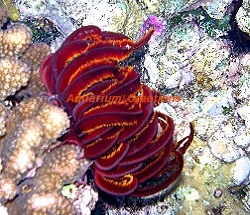
Click view Red Feather Star Swimming
Description:
The Feather Starfish is an unusual species that looks more like a plant than a Starfish. The arms, which have feathery fringes and can be used for swimming, usually number five. Feather stars use their grasping “legs” (called cirri) to perch on sponges, corals, or other substrata and feed on drifting microorganisms, trapping them in the sticky arm grooves. Feather stars traditionally belong to a single order (Comatulida) and are often referred to as “comatulids”; however, some authorities divide these animals into several orders. It ranges in color from brown to orange, yellow, and black. Like the Basket Star, the Feather Starfish is a filter feeder. It is nocturnal, and at night it can be found with its long arms unfurled where it filters plankton from the water. When stressed, the feather star may shed its arms and cirri and later on regenerates them. The image represents general look of the animal. Expect some diversity since each animal is unique in color and pattern.
Notes:
Feather Sea Star requires moderately strong water current in the marine aquarium it inhabits. They are intolerant of sudden changes in oxygen levels, salinity and pH of the water, and cannot tolerate copper-based medications. Extra care and time should be taken whenever acclimating this animal.The drip acclimation method is highly recommended for all Sea Stars due to their intolerability to changes in water chemistry. Starfish must never receive exposure to air during acclimation. Keep the water quality high by regularly changing the water of your marine aquarium and installing an efficient protein skimmer. High quality water is essential for the sound health of Feather Sea Star.
This animal requires a long, slow drip acclimation period of no less than 2-1/2 hours in order to properly adjust to the parameters in your aquarium. It requires the aquarium to maintain a salinity of 1.025 ppm. Lower salinities will shorten the life of this animal and incorrect acclimation procedures will void the livestock guarantee.
Food and diet:
The Feather Sea Star is a Planktivorous in feeding habit. They eat zooplankton and phytoplankton. Supplement their diet with liquefied plankton food, a few times per week.
Level of Care:
Expert. Only expert aquarists should handle and maintain Feather Sea Star. No guarantee beyond live arrival.
Acclimaton Time:
2+ hours
Reef Compatibility
: Excellent
Approximate Purchase Size:
4 - 6 inches.
|
|
Basket Star
Astrophyton muricatum
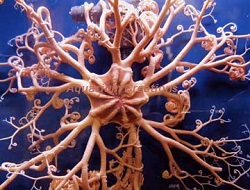 Click to view Basket Star Feeding
Click to view Basket Star Feeding
Description:
Basket starfish, Astrophyton muricatum, are an unusual starfish found throughout Florida and the Caribbean. By day they are usually a tightly coiled into a ball hidden under a rock, or clumped up on a gorgonian, but by night they open up into a mass of waving arms that feed on plankton. They can get quite big, but we select smaller ones that are more suitable for most aquariums. The average size we sell open up to about 5″ and have a central disk that is about an 0.5 inches in diameter. Basket stars are quite unique though, as they're suspension feeders that open their arms into the current and snare anything that bumps into one of them. Anything from large zooplankton to small fishes can be grabbed this way, and then passed to the mouth and eaten. Colors vary greatly on these from red to orange to black.
Notes:
Feather Sea Star requires moderately strong water current in the marine aquarium it inhabits. They are intolerant of sudden changes in oxygen levels, salinity and pH of the water, and cannot tolerate copper-based medications. Extra care and time should be taken whenever acclimating this animal.The drip acclimation method is highly recommended for all Sea Stars due to their intolerability to changes in water chemistry. Starfish must never receive exposure to air during acclimation. Keep the water quality high by regularly changing the water of your marine aquarium and installing an efficient protein skimmer. High quality water is essential for the sound health of Feather Sea Star.
This animal requires a long, slow drip acclimation period of no less than 2-1/2 hours in order to properly adjust to the parameters in your aquarium. It requires the aquarium to maintain a salinity of 1.025 ppm. Lower salinities will shorten the life of this animal and incorrect acclimation procedures will void the livestock guarantee.
Food and diet:
Basket stars can easily be fed in the evening, just let some Mysis or Artemia drift into their arms, they will immediately curl up and stuff the food into their mouth, which is on the bottom of the star, facing towards the substrate. They do have an opening at the top, but that is the rear end. "
Level of Care:
Expert. Only expert aquarists should handle and maintain Feather Sea Star. No guarantee beyond live arrival.
Acclimaton Time:
2+ hours
Reef Compatibility
: Excellent
Approximate Purchase Size:
4" to 6"
|
Serpant Star, Colored
Ophioderma spp.
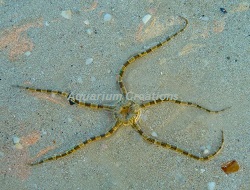
Description:
Often called Caribbean Serpent Sea Star or a Tiger Serpent Starfish, they are nicely Colored Serpent Stars. They come in a variety of colors. All have a central, disc and 5 arms. If an arm falls off it quickly regenerates. The central disc and arms can have variable markings. These elusive starfish will spend most of their time resting under your rocks. Some will come out when they smell fish food added to the tank. Most often you will see their legs hanging out from under the rocks hoping to grab some fish food floating nearby. They are great tank cleaners because they will eat any uneaten fish food that would normally get stuck & decay under our rocks. Can sometimes be seen roaming the tank at night after the lights are off.
Tank Recommendations:
They do well in an aquarium if provided with ample hiding places and plenty of room to roam. A tank with live rock, and a sandy bottom, as this is their natural habitat.
Food and diet:
The Colored Serpent Star should be fed small pieces of chopped meat, shrimp, mussel, or fish.
Level of Care:
Easy
Acclimaton Time:
1+ hours
Reef Compatibility:
Excellent
Approximate Purchase Size:
4" to 6"
|
|
|
Harlequin Serpent Star
Ophioderma spp.
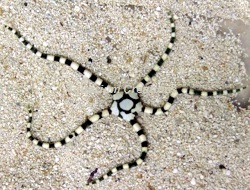
Description:
Harlequin serpent stars, Ophioderma appressum, are very attractive starfish that are suitable for any reef tank. There is quite a bit of color and pattern variation in this species, but we try to stick with the ones that look close to the picture with markings on their head and legs. These serpents are real easy to take care of and really require no special care at all. They will usually be hiding under rocks during the day, but as soon as you put food in the water they will come out and actively feel around for food. These starfish will eat anything that gets past your fish, shrimp, and crabs, and they’re especially good at finding all those lost food particles that fall behind and under the rocks, so you don’t have to worry about stray bits of food fouling the water. They also respond well to directed feeding if you’re inclined to do that, but it isn’t necessary in most cases.
Tank Recommendations:
They do well in an aquarium if provided with ample hiding places and plenty of room to roam. A tank with live rock, and a sandy bottom, as this is their natural habitat.
Food and diet:
The Harlequin Serpent Star should be fed small pieces of chopped meat, shrimp, mussel, or fish.
Level of Care:
Easy
Acclimaton Time:
1+ hours
Reef Compatibility
: Excellent
Approximate Purchase Size:
3" to 6"
|
Red Brittle Sea Star
Ophiocoma sp
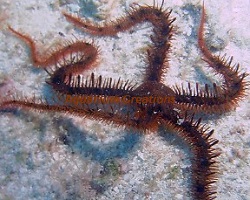
Description:
The Red Brittle Sea Star are some of the hardest working Cleaners available. Found throughout the Caribbean, they have a red central disc, with different patterns. The spiny red arms covered with a white pattern and spines. They are wonderful reef inhabitants that always seem to be looking for some bit of uneaten food in even the tiniest of crevices. It is nocturnal and often hides under rocks during the day. At night, it comes out to eat detritus, left-over food and small organisms.
Tank Recommendations:
The Red Brittle Star is best in the established saltwater aquarium with plenty of live rock for hiding. Since Brittle Stars of all kinds are nocturnal, during the daytime they will hide under the rocks. At night coming out to eat detritus and small organisms.
Food and diet:
Feed Brittle Starfish a varied diet of frozen mysis and brine shrimp, mussel, clam, raw table shrimp, and smelts, silversides. Brittle Stars will eat any leftovers from other aquarium inhabitants. Best to feed once a day. As long as the central disc is meaty in appearance, the Brittle Star is feeding well. Just remember predatory hunting may occur if the brittle star is not fed enough.
Level of Care:
Easy
Acclimaton Time:
1+ hours
Reef Compatibility
:Excellent
Approximate Purchase Size:
3 to 6 inches.
|
Brittle Sea Star, Fancy
Ophiure protoreaster
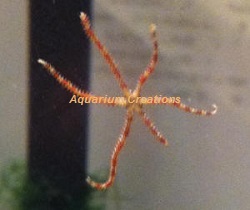
Description:
The Fancy Brittle Sea Star are some of the hardest working Cleaners available. Found throughout the Caribbean, they have a red central disc, with different patterns. The spiny red arms covered with a white pattern and spines. They are wonderful reef inhabitants that always seem to be looking for some bit of uneaten food in even the tiniest of crevices. It is nocturnal and often hides under rocks during the day. At night, it comes out to eat detritus, left-over food and small organisms.
Tank Recommendations:
The Fancy Brittle Star is best in the established saltwater aquarium with plenty of live rock for hiding. Since Brittle Stars of all kinds are nocturnal, during the daytime they will hide under the rocks. At nightcoming out to eat detritus and small organisms.
Food and diet:
Feed Brittle Starfish a varied diet of frozen mysis and brine shrimp, mussel, clam, raw table shrimp, and smelts, silversides. Brittle Stars will eat any leftovers from other aquarium inhabitants. Best to feed once a day. As long as the central disc is meaty in appearance, the Brittle Star is feeding well. Just remember predatory hunting may occur if the brittle star is not fed enough.
Level of Care:
Easy
Acclimaton Time:
1+ hours
Reef Compatibility
:Excellent
Approximate Purchase Size:
3 to 6 inches.
|
|
| |


 Click to view Basket Star Feeding
Click to view Basket Star Feeding


